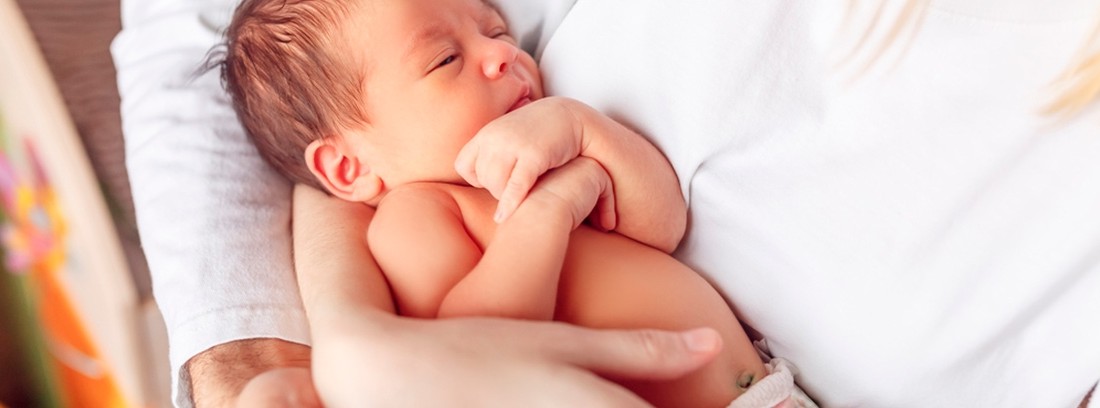Physical characteristics of the newborn

Throughout the pregnancy the fetus has matured to be able to coping with life outside the womb maternal. Birth is a challenge for the newborn and the first contact with the outside world. The first time parents see their newborn it may surprise them.
The weight, of a baby who is born on the expected date, can range between 2500 and 4000 grams and measure about 50 cm. A newborn born between 37 and 42 weeks gestation is called a full-term newborn; If it is born before 37 weeks it is called preterm and after 42 weeks it is called post-term. These last two situations are not ideal for the newborn, so they may have a health problem.
General appearance and skin of the newborn
His body is warm and his skin is covered with a greasy, whitish substance called vernix caseosa (It is produced by the skin of the fetus in the last stage of pregnancy and serves to protect the skin). They also present a fine layer of hair on the arms, legs and back called lanugo. Both vernix caseosa and lanugo will fade over time.
Color at birth can be slightly bluish, it will become pinkish for the first few minutes. Hands and feet may be whitish or bluish for a few more hours. It is important to keep the newborn warm and maintain skin-to-skin contact with the mother (it is the best source of heat for the baby); as they are so fragile they still do not know how to regulate the temperature and can cool down very quickly.
The skin, which is also adapting to a different environment than the womb, usually flakes during the first days, in the form of small sheets.
A few whitish spots may appear on the face called million that will disappear after a few days. These points may also be present on the gums and are called ebstein pearls.
Head
Is proportionally larger than the rest of the body. In non-cesarean deliveries the head may take an elongated shape due to the passage of the baby through the birth canal. In a few days it will return to its normal shape. The face may be a little swollen, especially the eyes and lips that will gradually decrease in volume.
On the newborn's head you can touch a few softer areas called fontanelles. This is so because the skull has not closed completely (it closes completely at 18 months of life). In some cases the cranial sutures may be ridged, because the skull has molded during passage through the birth canal. Everything returns to normal in a few days.
The baby hair is fine and soft and falls progressively.
The eyes have a bluish appearanceAlthough the final color we will not be able to know until 6-12 months. Most newborns do not conjugate their gaze, that is, the two eyes do not go at one and it may appear that they are crossed. With the days vision matures and the look is already normal.
Extremities
They are usually flexed, the newborn is curled up, in a fetal position, during the first weeks of life. The feet and hands may take longer than the rest of the body to turn pink after birth. The . There are newborns who are born with very long fingernails; To prevent them from scratching their faces, they can be put on mittens.
Newborn chest and abdomen
Due to the mother's hormones, some newborns have a inflammation of the mammary gland, you can even see a drop of milk; it is not important and disappears with the days.
It is held on the belly with a plastic clamp. When it falls, in a week or two, it will leave a scar which is the navel.
Genitals
Is it so always a little swollen. In the case of girls, due to the passage of hormones from the mother, discharge and small vaginal bleeding (such as menstruation) can be observed; do not be alarmed, it is completely normal. In boys, the testicles are felt within the scrotum, which may be slightly swollen.
Breathing and pulse
The newborns breathe very fast and irregularly. They take about 40 breaths a minute. The heart also goes very fast, between 80 to 180 beats per minute (depending on whether you are asleep or awake)
Urine and feces
The newborn's first urination it must be in the first 24 hours, is a sign that your kidneys are working well and that you are getting the right food.
The first few stools are very black and sticky (like tar or pitch) and are called meconium. The first meconium it must occur within the first 48 hours; It is made up of mucus, bile salts and epithelial debris that the baby has been swallowing inside the mother's womb. Once all of this has been expelled, your stool will be yellow to green, lumpy, and runny.
With it you will have assistance throughout the pregnancy. In addition, if you wish, you can incorporate it into your policy other optional features with all the guarantee and experience of the professionals who are part of MAPFRE.
CALCULATE YOUR PRICE
Dra. Esther Martínez García Pediatric Specialist Advance Medical Consultant Physician
(Updated at Apr 13 / 2024)